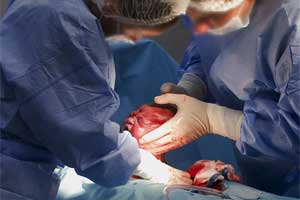- Home
- Editorial
- News
- Practice Guidelines
- Anesthesiology Guidelines
- Cancer Guidelines
- Cardiac Sciences Guidelines
- Critical Care Guidelines
- Dentistry Guidelines
- Dermatology Guidelines
- Diabetes and Endo Guidelines
- Diagnostics Guidelines
- ENT Guidelines
- Featured Practice Guidelines
- Gastroenterology Guidelines
- Geriatrics Guidelines
- Medicine Guidelines
- Nephrology Guidelines
- Neurosciences Guidelines
- Obs and Gynae Guidelines
- Ophthalmology Guidelines
- Orthopaedics Guidelines
- Paediatrics Guidelines
- Psychiatry Guidelines
- Pulmonology Guidelines
- Radiology Guidelines
- Surgery Guidelines
- Urology Guidelines
GA in category 1 CS linked to higher adverse neonatal outcomes

According to a new study general anaesthesia (GA) for category 1 caesarean section (CS) was associated with a higher incidence of an adverse neonatal outcome. The study has been published in the Indian Journal of Anaesthesia.
Category 1 CS should be performed as early as possible, within 30 min of the decision, as there is an immediate threat to the mother or the fetus. Anaesthetic technique for category 1 caesarean section, CS might vary depending on several factors. Even though the most commonly used technique is SA, there are some conditions where GA is preferred by the attending anesthesiologist.
Read Also: Mandatory Second Opinion to reduce Unnecessary C-Sections: WHO 2018 Guidelines
Chitra Rajeswary Thangaswamy and her associates conducted a prospective observational cohort study in a tertiary care institute and research centre in south India. Consecutive patients more than 18 years who underwent caesarean section,CS for category 1 indication during the 1-year period from August 2014 to August 2015 were included in the study.
Patient characteristics, indication for caesarean section, CS, decision-to-delivery interval (DDI), uterine incision-to-delivery time (UIDT), cord blood pH, Apgar scores and neonatal and maternal outcome were noted. Composite endpoint (Apgar score <7, umbilical cord blood pH <7.2, neonatal intensive care unit admission or death) was created for an adverse neonatal outcome. Logistic regression was done to assess the influence of confounding factors on the occurrence of the adverse neonatal outcome. Of 123 patients who underwent category 1 cesarean section, 114 patients were included for analysis.
The key study findings included are:
- The DDI and UIDT were comparable.
- One and 5-min Apgar scores were significantly lower in the group general anaesthesia (GA) than in the group spinal anaesthesia (SA).
- The umbilical cord blood pH was comparable (7.21 ± 0.15 vs 7.25 ± 0.11 in groups GA and SA, respectively).
- Neonatal intensive care admission and maternal outcome were comparable in both the groups.
- Subgroup analysis of patients with the fetal heart rate of less than 100 showed that group GA had significantly lower 1-min Apgar scores and umbilical cord blood pH and significantly more neonatal admission and mortality.
- Binominal logistic regression showed that group GA and gestational age were independently associated with adverse neonatal outcome.
Read Also: More labour time can cut Caesarean delivery rates by half-study
The observations in this study suggest that parturients receiving GA for category 1caesarean section, CS had significantly low 1- and 5-min Apgar scores. Parturients receiving GA had 2.9 times more odds of having an adverse neonatal outcome compared with parturients receiving SA, ”write the authors.
The study concluded that GA for category 1 CS was associated with a higher incidence of adverse neonatal outcome with comparable maternal morbidity and mortality.
For full information log on to 10.4103/ija.IJA_406_18

Disclaimer: This site is primarily intended for healthcare professionals. Any content/information on this website does not replace the advice of medical and/or health professionals and should not be construed as medical/diagnostic advice/endorsement or prescription. Use of this site is subject to our terms of use, privacy policy, advertisement policy. © 2020 Minerva Medical Treatment Pvt Ltd